Simplex
![]()
Hypertetrahedron is a redirect to this article. For the also so called 4-dimensional special case see pentachoron.
In geometry, a simplex or n-simplex, occasionally also an n-dimensional hypertetrahedron, is a special n-dimensional polytope.
A simplex is the simplest form of a polytope. Each 







A 3-simplex or tetrahedron
Definitions
Affine independence
Let 






In other words, there is no 






A set of points of an 




Simplex
Let 






The points 

![(t_{0},...,t_{k})\in [0,1]^{k+1}](https://www.alegsaonline.com/image/31f1ef2e160d6165c07dad6c28ff916d8b5cc1bd.svg)




Sides and edge
Let Δ be 







The number of 



The 

Example
- A 0 simplex is a point.
- A 1-simplex is a distance.
- A 2-simplex is a triangle.
- A 3-simplex is a tetrahedron (four corners, four sides of triangles, six edges); it is created from a triangle (2-simplex) to which a point not in the triangle plane is added and connected to all corners of the triangle.
- A 4-simplex is also called a pentachoron.
- An example of an
-simplex in
(and specifically one with a right-angled corner at the origin) is given by
given. This simplex is called a unit simplex. It is spanned by the zero vector and the unit vectors 



Search within the encyclopedia

